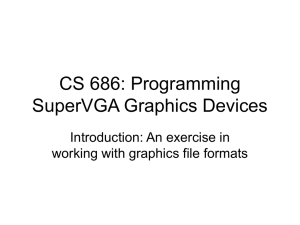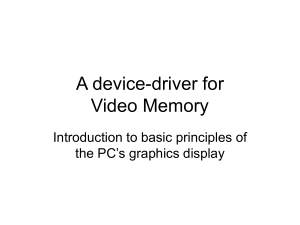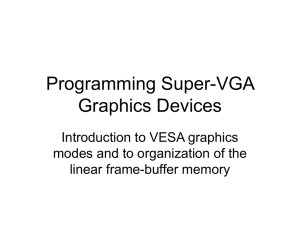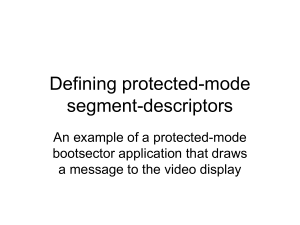CS 686: Programming SuperVGA Graphics Devices Introduction: An exercise in
advertisement
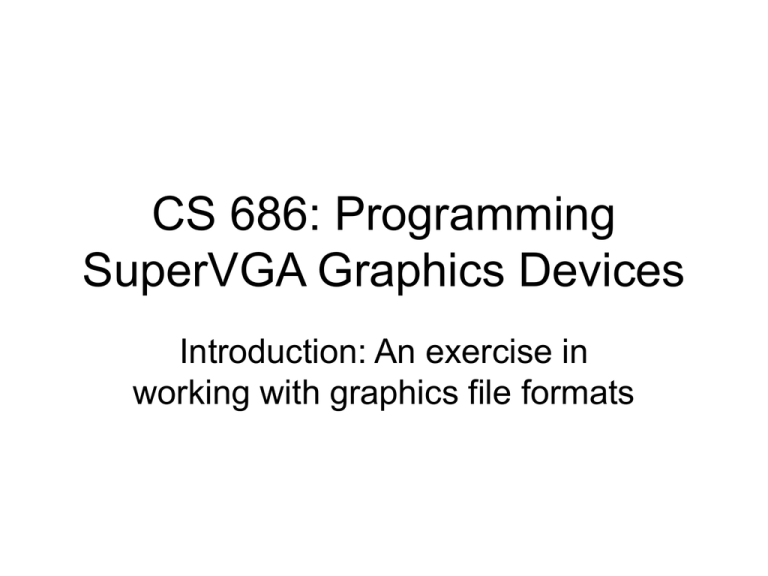
CS 686: Programming
SuperVGA Graphics Devices
Introduction: An exercise in
working with graphics file formats
Raster Display Technology
The graphics screen is a two-dimensional array of picture elements (‘pixels’)
These pixels are redrawn sequentially, left-to-right, by rows from top to bottom
Each pixel’s color is an individually programmable mix of red, green, and blue
Special “dual-ported” memory
VRAM
CRT
CPU
32-MB of VRAM
RAM
1024-MB of RAM
Graphics programs
• What a graphics program must do is put
appropriate bit-patterns into the correct
locations in the VRAM, so that the CRT
will show an array of colored dots which in
some way is meaningful to the human eye
• So the programmer must understand what
the CRT will do with the contents of VRAM
How much VRAM is needed?
• This depends on (1) the total number of pixels,
and on (2) the number of bits-per-pixel
• The total number of pixels is determined by the
screen’s width and height (measured in pixels)
• Example: when our “screen-resolution” is set to
1280-by-960, we are seeing 1,228,800 pixels
• The number of bits-per-pixel (“color depth”) is a
programmable parameter (varies from 1 to 32)
• Some types of applications also need to use
extra VRAM (for multiple displays, or for “special
effects” like computer game animations)
How ‘truecolor’ works
24
longword
alpha
16
8
red
green
R
G
0
blue
B
pixel
The intensity of each color-component within a pixel is an 8-bit value
Intel uses “little-endian” order
VRAM
0
1
2
B
G
R
3
4
5
6
B
G
R
Video Screen
7
8
9
10
B
G
R
Some operating system issues
•
•
•
•
•
•
•
•
Linux is a “protected-mode” operating system
I/O devices normally are not directly accessible
On Pentiums: Linux uses “virtual memory”
Privileged software must “map” the VRAM
A device-driver module is needed: ‘vram.c’
We can compile it using: $ make vram.o
Device-node: # mknod /dev/vram c 99 0
Make it ‘writable’: #chmod a+w /dev/vram
VGA ROM-BIOS
• Our graphics hardware manufacturer has
supplied accompanying code (‘firmware’)
that ‘programs’ VGA device components to
operate in various ‘standard’ modes
• But these firmware routines were not
written with Linux in mind: they’re for
interfacing with ‘real-mode’ MS-DOS
• Some special software is needed (‘lrmi’)
Class demo: ‘pcxphoto.cpp’
•
•
•
•
•
•
•
First: several system-setup requirements
Some steps need ‘root’ privileges (‘sudo’)
Obtain demo sources from class website
Install the ‘mode3’ program (from svgalib)
Compile character device-driver: ‘vram.c’
Create ‘dev/vram’ device-node (read/write)
Start Linux in ‘text mode’ (need to reboot)
Typical ‘program-structure’
Usual steps within a graphics application:
–
–
–
–
Initialize video system hardware
Display some graphical imagery
Wait for a termination condition
Restore original hardware state
Hardware Initialization
•
•
•
•
•
•
The VGA system has over 300 registers
They must be individually reprogrammed
Eventually we will study those registers
For now, we just ‘reuse’ vendor routines
Such routines are built into VGA firmware
However, invoking them isn’t trivial (since
they weren’t designed for Linux systems)
Obtaining our image-data
•
•
•
•
•
•
•
Eventually we want to ‘compute’ images
For now, we ‘reuse’ pre-computed data
Data was generated using an HP scanner
It’s stored in a standard graphic file-format
Lots of different graphic file-formats exist
Some are ‘proprietary’ (details are secret)
Other formats are public (can search web)
Microsoft’s ‘.pcx’ file-format
FILE HEADER (128 bytes)
IMAGE
DATA
(compressed)
COLOR PALETTE
(768 bytes)
Run-Length Encoding (RLE)
• A simple technique for ‘data-compression’
• Well-suited for compressing images, when
adjacent pixels often have the same colors
• Without compression, a computer graphics
image-file (for SuperVGA) would be BIG!
• Exact size depends on screen-resolution
• Also depends on the display’s color-depth
• (Those parameters are programmable)
How RLE-compression works
If multiple consecutive bytes are identical:
example:
0x29 0x29 0x29 0x29 0x29
(This is called a ‘run’ of five identical bytes)
We “compress” five bytes into two bytes:
the example compressed: 0xC5 0x29
Byte-pairs are used to describe ‘runs’:
Initial byte encodes a ‘repetition-count’
(The following byte is the actual data)
Decompression Algorithm
int
i = 0;
do {
read( fd, &dat, 1 );
if ( dat < 0xC0 ) reps = 1;
else { reps = (dat & 0x3F); read( fd, &dat, 1 ); }
do { image[ i++ ] = dat; } while ( --reps );
}
while ( i < npixels );
Standard I/O Library
• We call standard functions from the C/C++
runtime library to perform i/o operations on
a device-file (e.g., vram):
open(), read(), write(), lseek(), mmap()
• The most useful operation is ‘mmap()’
• It lets us ‘map’ a portion of VRAM into the
address-space of our graphics application
• So we can ‘draw’ directly onto the screen!
Where will VRAM go?
•
•
•
•
•
•
We decided to use graphics mode 0x013A
It’s a ‘truecolor’ mode (32bpp)
It uses a screen-resolution of 640x480
Size of VRAM needed: 640*480*4 bytes
So we ‘map’ 2-MB of VRAM to user-space
We can map it to this address-range:
0xB0000000-0xB2000000
Virtual Memory Layout
kernel
space
(1GB)
Linux kernel
stack
VRAM
0xC0000000
0xB0000000
user
space
(3GB)
runtime library
code and data
0x40000000
0x08048000
Color-to-Grayscale
• Sometimes a color image needs to be
converted into a ‘grayscale’ format
• Example: print a newspaper photograph
(the printing press only uses ‘black’ ink)
• How can we ‘transform’ color photos into
black-and-white format (shades of gray)?
• ‘gray’ colors use a mix of red+green+blue,
these components have EQUAL intensity
Color-conversion Algorithm
struct { unsigned char r, g, b; } color;
int avg = ( 30*r + 49*g + 11*b )/100;
color.r = avg; color.g = avg; color.b = avg;
long
pixel = 0;
pixel |= ( avg << 16 );
// r-component
pixel |= ( avg << 8 );
// g-component
pixel |= ( avg << 0);
// b-component
vram[ address ] = pixel; // write to screen
In-class exercise
• Revise the ‘pcxphoto.cpp’ program so that
it will display (1) the ‘color-table’, and then
(2) the scanned photograph, as ‘grayscale’
images (i.e., different intensities of gray)
